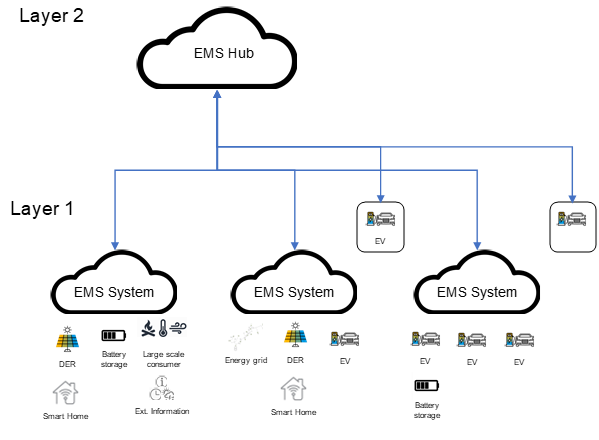work packages

Work Package 1
The aim of WP 1 is to introduce an energy management system for jointly managed loads/generations (resources) with the aim of minimizing energy usage and energy costs in the system. For this purpose, the system will be implemented in a structured manner in two stages. In the first stage, the energy management system (EMS) is created for a local aggregation of resources. This controller coordinates the generation (solar panels, wind), storage (battery), and usage (bidirectional charging station and other loads) of energy. To do this it requires an IoT-enabled remote monitoring infrastructure on the user side as well as a 5G-enabled, ultra-low latency communications to collect required data in real-time, and incorporate weather and energy price forecasts into the optimization process. This provides a recommendation for the household/customer’s energy configuration and estimates the expected energy usage of the household.
In the second stage, with an EMS Hub, the user is given the option to optimize across multiple EMS platforms. In this way, the total electrical load in the distribution grid can be reduced. At the same time, this reduces the carbon footprint of energy generation by using green, self-generated energy, such as solar and wind, instead of coal and oil-based energy.
Started
Work Package 2
The goal of Work Package 2 is to achieve further optimization of energy management through communication between various individual EMS systems. This optimization involves, for the first time, electric vehicles (EVs) as a means of transporting energy and people from one EMS system to another. The research objective is to explore the possibilities of using such a transport process to smooth the aggregated power demand of EMS systems from the distribution system operator’s perspective. Requirements for power optimization and data transmission, especially latency and data throughput, will be theoretically determined. Likewise, the structure and optimization for the EMS hub in terms of communication will be explored and described.
Started
Work Package 3
The goal of Work Package 3 is to realize self-learning optimization of Energy Management Systems (EMS) through 5G and AI. The objective is to maximize the use of locally generated energy and minimize reliance on fossil fuels. While cost-efficiency and environmental friendliness are critical factors, there are many other elements to optimize, including energy storage, grid stability, peak load management, and user demand patterns. To achieve the optimization of these parameters the strong capabilities of AI are taken into account. Locally generated energy is the most cost-effective, and clean energy is the most environmentally friendly. To maximize the consumption of this green energy, it will be integrated into the charging processes through an AI ready campus EMS. Additionally, Work Package 3 involves building a testbed of chargers to simulate charging processes and conduct experiments to optimize our output.
Started
Work Package 4
- Downscaled testbed finished.
- Demostrator finished.
- Virtual testbed v1 finished, v2 under development
- Physical testbed in progress.
Work Package 5
Project management.
